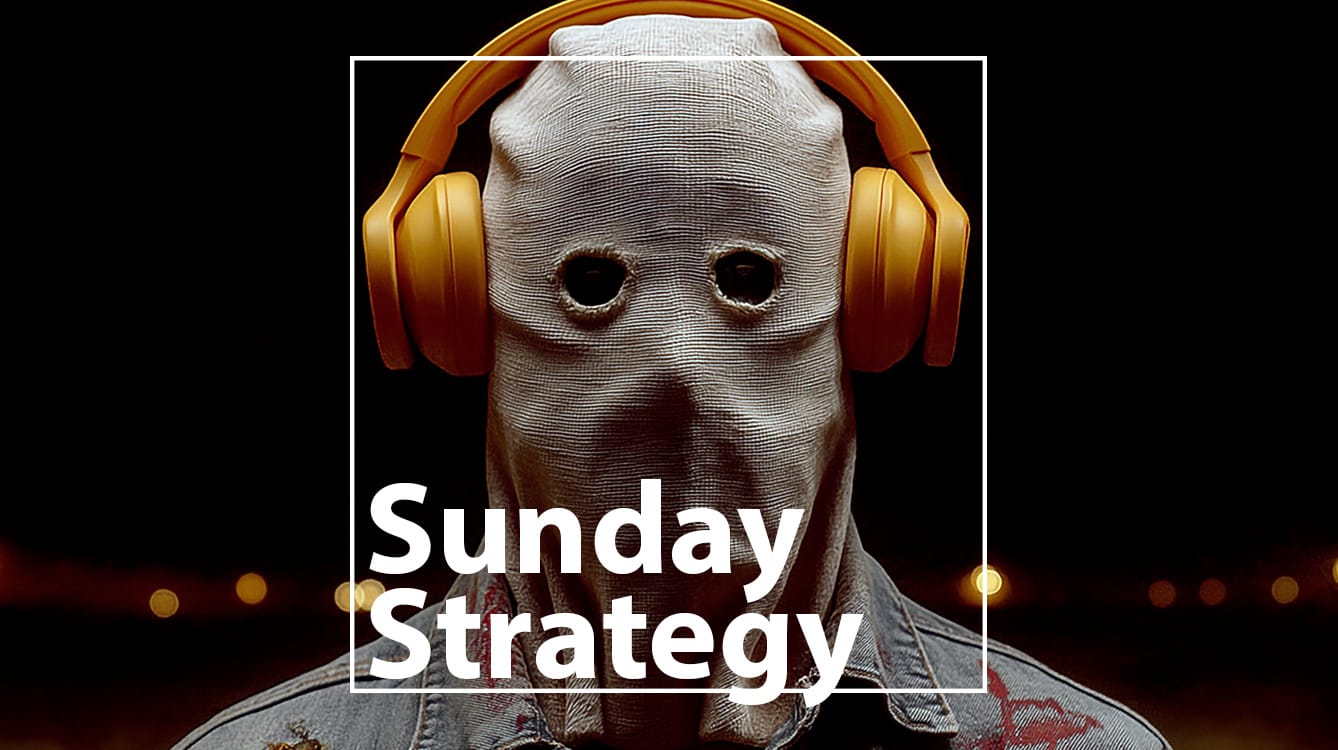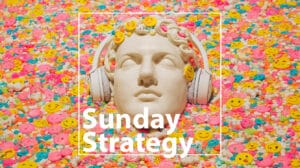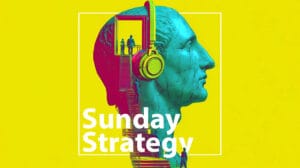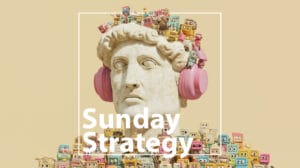In this issue of Sunday Strategy, we look at six stories to think about next week, including: Branded Horror, Flyers on the Rise, Sora and Social Media , Hiring for Obsolescence, Streaming Behaviors and Worries on Professional Wearables.
In addition, we have ads from: Jeep, Ocean Spray, Columbia and AT&T.
// Stories of the Week:
1.) Halloween Ads Turn to Branded Horror.
With Halloween nearly upon us, Halloween brand activations are in full swing to take advantage of nearly $290 average spend per consumer for the holiday. Though amongst the normal advertising featuring BK’s vampire nuggets, McDonald’s Frankenstein burger or Rivian’s ‘Spooky Swamp’ more brands have turned to long form horror over traditional Halloween fare. Yahoo, Hatch, Six Flags and Gushers are just some of the brands that have gone full horror, recruiting celebrities and making tension filled horror shorts and parodies for the season.
Why the shift now? The answer may lie in horror as a genre growing in popularity and scope, with new stories, formats and platforms like TikTok pushing scares into new areas. The genre offers rich tropes and cliches to parody, as well as providing a chance to play with a wider range of emotions – moving beyond nostalgia or trick or treat and closer to scares.
2.) Flyers on the Rise
What’s old is seemingly new again. The New York Times reports that analog flyer distribution has surged, with printing shops reporting demand tripling in the past year. People are using flyers for everything from podcasts and events to memes and personal projects, creating something tactile and real in an ‘AI-heavy world’. Industry observers call flyers “the original ad” making a comeback as a counterpoint to digital saturation – something that is also reflected in increasing OOH spend.
However, with the potential for innovative ads to be shared on social media – it may start in the real world but still finish online. From look-a-like contest to parties, flyers are increasingly a format we recognize in the real world and in social media.
3.) Sora Won’t Kill This Age of Social Media, It’s the Mascot for It.
With over 1m downloads in its first week, OpenAI’s Sora app, part social network and part GenAI, may seem like the death of this age of social media. However, what if it actually shows the true reality for social media as it currently exists? Modern social media is no longer social. We engage with content more frequently than our friends, participating in a content marketplace that operates like a UGC Netflix. Even before the shift away from friends, we engaged more with the vision for how our friends wanted to be perceived vs. how they actually were. De-influencing could only do so much.
Sora’s GenAI powered offering amplifies both of these aspects of modern social media. It gives everyone the ability to create content to serve to others, further unmoored from any lived part of the creator’s daily life and focused more on the ‘vision’ they want to sell. Even cameos, the feature where users can insert their likeness into creations, doesn’t add a social aspect to the network – as wider use is still focused on celebrities. While Sora’s success isn’t assured, it doesn’t represent a new age of social media vs. a peak of the current one.
4.) Hiring to Fire Your Old Job with AI.
OpenAI is reportedly hiring ex JPMorgan bankers to train the AI to build financial models and replicate their old jobs. For $150 / hour under the name ‘Project Mercury’, the employees are writing prompts for a range of transactions and types of work. Hiring to train AI in specific skill sets isn’t new or unique, Uber recently asked drivers to do the same as a side task, but the focus on financial services is interesting for a few reasons.
Modern financial service is both more repetitive than some would assume on the outside and, arguably, less refined than people would assume. Many complex financial models have been jokingly referred to as Excel macros propping up the global economy. The repetition gives AI an opportunity to add immediate value and a lack of sophistication creates a long term value – making it a rich industry for AI to train against and shift. The only outstanding question is who is best positioned to weaponize cognitive surplus for AI, platforms like OpenAI picking up ex-employees or banks using current employees to ‘fire themselves’.
5.) Are You Still Watching?
Netflix’s new ‘Still Watching’ global streaming report highlights how viewers are engaging with streaming services. The report positions streaming as a discovery engine with 76% of Millennials and Gen Z saying they go to streaming platforms to find something new and 83% say streaming content has ‘broadened their view of the world’. 79% of viewers even say they’ve surprised themselves with some of the titles and movies they’ve liked. Netflix’s position is seemingly built on variety, as respondents also say they are 3x more likely to choose Netflix vs. competitors due to its abundance and variety of content.
The report shows the underlying tension with large scale streaming services, requiring a breadth of content to service discovery and variety vs. other more specialist services centered on certain genres or IP.
6.) The Sinister Overtones of Professional Wearables
Amazon has unveiled smart glasses for employees, which can help delivery staff find packages in trucks, homes to deliver to and report defects on the fly. The neon green aesthetic of the HUD in the glasses has drawn comparisons to the ‘Pip Boy’ from the Fallout video game. However, do the dystopian cues stop there?
Professional wearables have been an opportunity for a range of devices, from those that struggled to find product market fit (like Microsoft’s Hololens) through to productivity hacks (like Amazon’s purported productivity tracking wrist band). While wearables provide the opportunity to allow us to do more of what we want in our personal lives, professional use often runs the risk of seeming dehumanizing. Has Amazon done enough to make this new technology seem like a genuine tool for employees, especially given their reputation to many?
// Ads You Might Have Missed:
1.) ‘The Family SUV’ – Jeep:
SUVs are undeniably useful for families, but what about those drivers looking to make one? Jeep’s new 2026 Wagoneer reveal taps into a random Jalopnik article, naming the car one of the best to have sex in, and runs with the joke. Featuring comedian Iliza Shlesinger pitching a concept that’s less family friendly than family creating (pushing ‘celebrity driven ad ideas’ in a new territory from Heinz’s Ed Sheeran entry). The result is an interesting way to talk about features, injecting humor into a category that often forgets how to stand out. Similar to 2011’s ‘Swagger Wagon’ ad from Toyota, Jeep talks to parents (and wider drivers) in a less expected way while showing the value in unexpected inspiration for brands.
2.) ‘Just Add Cran. Beware of Cranpus’ – Ocean Spray:
Ocean Spray’s biggest holiday campaign introduces Cranpus, a mischievous character played by Bryan Cranston. A 60‑second film shows Cranpus sneaking cranberries into holiday dishes and gate‑crashing Christmas scenes to showcase the versatility of cranberries and the brand’s product range. Cranston is a playful anti‑Santa that brings star power and humor, reminding consumers that cranberry products can be for more than Thanksgiving by showing up early in the cultural calendar (making it of the first 2025 entries in our 1,000+ list of Christmas ads through the years)
3.) ‘Death Wish’ – Columbia:
Columbia sportswear has taken a seasonally appropriate approach to talking about product longevity. Their ‘Death Wish’ limited edition line of clothing, promoted by the Grim reaper as a social media influencer, features a last will and testament stitched into each garment. The brand claims that the clothing may outlive you, allowing the integrated will to ensure the jacket gets to someone else in your life. The limited edition is being given away in social media, appropriately to users who share the best near death outdoor stories.
4.) ‘Ain’t Our First Rodeo’ – AT&T:
AT&T’s new campaign positions the brand as a consumer advocate and takes aim at competitors’ deceptive promotions. Leveraging historical claims as America’s “first network.”, the ad doubles down on folksy charm with Actor Luke Wilson narrating in a style that’s as much ‘Yellowstone’ as his brothers’ ‘Lightning McQueen’. The heritage route into advocacy is backed by a promotion claiming that if competitors’ services don’t live up to claims, AT&T will give a free month of service.
// Sunday Snippets
// Marketing & Advertising //
– McDonalds Sweden launches an arch focused nightlife campaign [Ads]
– Against travel concerns, Brand USA launches the ‘America the Beautiful’ tourism campaign [Travel]
– Lysol use the Jersey Shore’s ‘Snooki’ to introduce ‘Stink Check’ [Ads]
– Herbal Essences reframes scent as a personal romantic calling card with ‘Scent Traps’ [Ads]
– German lift company becomes new star of the Louvre heist after being used in the robbery [Ads]
– Mondelez announces 30-50% cost savings through Generative AI use for advertising creation [AI]
– Xbox leans into multi-modal gaming in their latest ad [Ads]
– eBay launches their ‘eBay Stories’ global platform [Ads]
– Tinder opens a ‘breakup shrine’ in Tokyo [Ads]
– BMW taps into ‘AI fakery’ in their ‘Real, for Real’ pre-owned vehicle program [Auto]
// Technology & Media //
– Apple re-enters the top 5 of India’s smartphone market [Tech]
– Sponsored creator content has reportedly increased 54% this year on YouTube [Social Media]
– Australian government sells teen social media ban with a new advertising campaign [Social Media]
– Wait, so our phones and smart TVs are listening to us? [Media]
– Modified Meta Raybans are circumventing the ‘privacy features’ such as a recording light [Tech]
– GM plans to remove Apple’s ‘Car Play’ from all new models [Tech]
– Wikipedia says AI summaries and social video are decreasing site traffic [AI]
– The recent AWS outage had one surprising victim – smart beds [Tech]
– WPP announces a managed service AI offering for clients, but is it the first step into rendering their own agencies obsolete? [AI]
– Amongst AI platform announcements, the Guardian asks ‘What’s wrong at WPP?’ [Media]
– With newspapers closing across the US, news deserts are growing [Media]
– Instagram rolls out ‘watch history’ allowing users to see what Reels they’ve viewed in the last 3 months [Social Media]
// Life & Culture //
– How did Middle Tennessee State University rethink NIL for their college football team? [Sports]
– Are we dressing to pretend to look rich? Haven’t we always? [Fashion]
– Just in time for ‘Croctober’, Crocs releases Croc Boots [Fashion]
– Why are we all dressing for the end of the world? [Fashion]
– The unexpected popularity of ‘K-Pop Demon Hunters’ has lead to Halloween costume chaos [Culture]
– With less difference between gambling and investing, do social and legislative norms around betting still work? [Culture]
– 15m more under 35s are living with their parents than a decade ago [Culture]
– Under 40s in the US reporting cognitive issues have doubled [Health]
// Until Next Sunday
As always, let me know what you think by email (dubose@newclassic.agency), website or on LinkedIn.
You can also listen to an audio summary and discussion of each week’s newsletter on Spotify. We’re also on TikTok!





